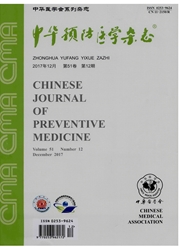

 中文摘要:
中文摘要:
目的了解准噶尔盆地东部区域大沙鼠(Rhombomys opimus)体蚤群落结构。方法采集2010—2014年大沙鼠体蚤的种类、染蚤率和蚤指数等数据信息,采用群落生态研究方法对其进行丰富度、多样性、均匀性和优势度等群落结构因子分析。结果准噶尔盆地鼠疫自然疫源地东部区域大沙鼠寄生蚤4科5属6种,平均染蚤率98.51%、总蚤指数9.18,其中簇鬃客蚤占65.8%,是大沙鼠的主要鼠体蚤,其次为粗鬃客蚤占27.8%,其他4种蚤占6.4%;大沙鼠体蚤群落中常见种2种,其余4种为稀有种,相对稀有种类数为66.7%,多样性低(0.485 0)、均匀性高(0.868 9)、优势度适中(0.512 3);从春季至秋季,总蚤指数呈现春秋季高,夏季低的"U"型变化,蚤种丰富度、多样性呈增高趋势,优势度下降;大沙鼠寄生蚤类群落中簇鬃客蚤和粗鬃客蚤占有的资源均最多,处于第一阶层,生态位宽度分别为0.939 8和0.924 1,其次为长吻角头蚤和秃病蚤指名亚种,处于第二阶层,第三阶层的则为叶状切唇蚤和重要狭蚤;时间维显示,6种蚤的3个生态位层次十分明显,且叶状切唇蚤(0.228 0)和重要狭蚤(0.000 0)在时间维上的生态位宽度较营养维更低。结论准噶尔盆地鼠疫自然疫源地东部区域大沙鼠寄生蚤群落与该疫源地其他区域存在一定的差异,具有群落组成的独特性,染蚤率和总蚤指数均高于准噶尔盆地鼠疫疫源地的平均水平,而丰富度、多样性低于平均水平,优势度较高;年季间蚤类群落结构指标存在一定的波动,并发生季节性的规律性变动。
 英文摘要:
英文摘要:
Objective To investigate the community structure of parasitic fleas on Rhombomys opimus in the eastern area of the Junggar Basin. Methods The data including flea species, parasitic rate and index of great gerbil collected during2010—2014, and the community structure factors of richness, diversity, evenness and dominance were analyzed with community ecology method. Results The parasitic fleas on Rhombomys opimus in the eastern area of the Junggar Basin included six species, belonging to five genus and four families. The average parasitic rate was 98.51%, with total flea index of 9.18.Among them, Xenopsylla skrjabini was the primary parasitic flea of Rhombomys opium, accounting for 65.8% and the secondary was Xenopsylla hirtipes, accounting for 27.8%, and the rest four fleas were rare with a relative rare species number of66.7%, a low diversity of 0.485 0, a high homogeneity of 0.868 9 and a moderate dominance of 0.512 3; total flea index was higher in spring and autumn than in summer, showing a changing trend of U shape. Richness and diversity had an increasing trend and dominance had a decreasing trend from spring to autumn; Xenopsylla skrjabini and Xenopsylla hirtipes were most in occupying resource and their niche breadths were 0.939 8 and 0.924 1, respectively, Echidnophaga oschanini and Nosopsyllus laeviceps laiveceps were secondary, and Coptopsylla lamellifer ardua and Stenoponia conspecta were minimal; the three levels were still significant for the temporal niche of the six fleas, and the niche breadth of Coptopsylla lamellifer ardua(0.228 0) and Stenoponia conspecta(0.000 0) was lower in time dimension than in nutrition dimension. Conclusions The community structure of parasitic fleas on Rhombomys opimus in the eastern area is different from the other areas in the Junggar Basin. The parasitic rate and total flea index are higher than the average level of the Junggar Basin plague focus, richness and diversity are lower than the average level, and the dominance is relatively high. The index of com
 同期刊论文项目
同期刊论文项目
 同项目期刊论文
同项目期刊论文
 期刊信息
期刊信息
